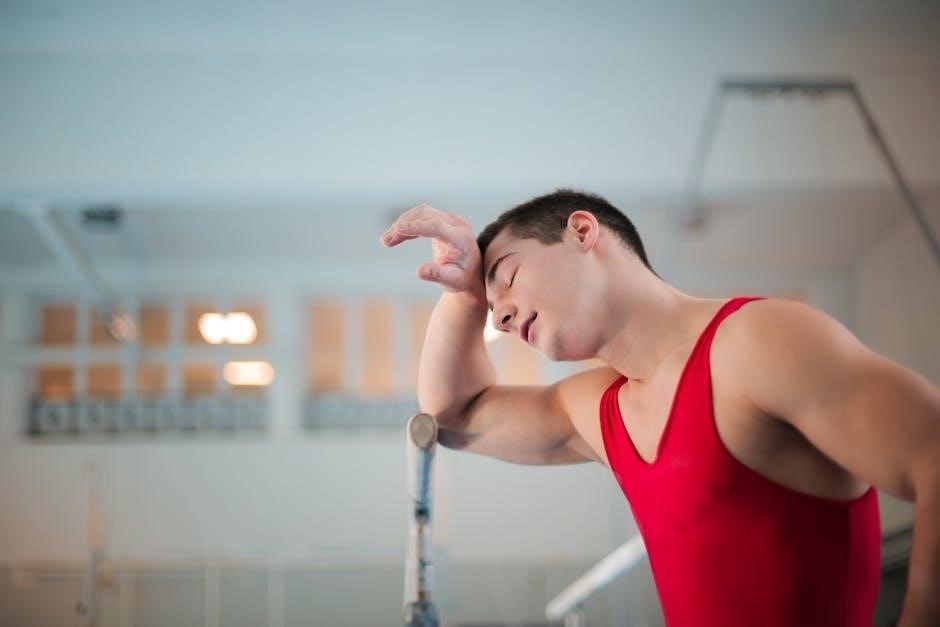Exercises for de quervains are designed to increase movement and strength‚ done slowly with controlled movement for best results‚ using
- lists
and following guidelines carefully always.
Understanding De Quervains Tenosynovitis
De Quervains tenosynovitis is a condition that affects the tendon sheath‚ the outer layer of the tendon‚ located at the thumb side of the wrist‚ where tendons connect muscle to bone to allow movement. The sheath becomes thickened and swollen‚ reducing movement and causing pain. This condition can be caused by repetitive movements or activities that put strain on the wrist and thumb. It is essential to understand the causes and symptoms of De Quervains tenosynovitis to develop an effective treatment plan. A healthcare provider can diagnose the condition and provide guidance on the best course of treatment‚ which may include exercises‚ physical therapy‚ or other interventions. By understanding the condition‚ individuals can take steps to manage their symptoms and prevent further injury. The condition can be treated with a combination of rest‚ ice‚ and exercises‚ and in some cases‚ a wrist and thumb splint may be recommended. Regular exercise and physical therapy can help to reduce pain and improve mobility.

Precautions and Disclaimer
Use caution when performing exercises‚ as there is a risk of injury‚ and discontinue if pain occurs‚ using guidelines carefully always.
Important Considerations Before Starting Exercises
Before starting exercises‚ it is essential to consider several factors‚ including the severity of your condition and any underlying health issues‚ using a
- list
to track progress and stay organized. You should also consult with your healthcare provider to determine the best course of treatment and to ensure that you are ready to begin exercising. Additionally‚ it is crucial to warm up before starting any exercise routine and to listen to your body and stop if you experience any pain or discomfort. By taking these precautions‚ you can help prevent further injury and ensure a safe and effective recovery. It is also important to have a clear understanding of the exercises and to follow the instructions carefully‚ using
- ordered lists
and links to access additional resources and information. This will help you to get the most out of your exercise routine and to achieve the best possible results.

Isometric Exercises for De Quervains
Exercises involve wrist and thumb movements‚ using links to guide proper technique and form always.
Wrist Flexion and Thumb Flexion Exercises
These exercises are crucial for rehabilitation‚ involving wrist and thumb movements to improve flexibility and strength. The patient should start with wrist flexion‚ using a resistance band or their own hand to create resistance‚ then move on to thumb flexion. A rubber band can be used around the thumb to provide resistance‚ with the other end held by the other hand. The exercises should be done slowly and carefully‚ with controlled movement‚ to get the best results. It is essential to follow the guidelines carefully and complete each exercise 2-3 times every second day. The exercises can be modified to suit individual needs‚ and it is crucial to listen to the body and stop if any pain or discomfort is experienced. By incorporating these exercises into a daily routine‚ patients can improve their wrist and thumb mobility and reduce the risk of further injury. Regular practice is key to achieving optimal results.

Opposition Stretch Exercise
Touch thumb to little finger‚ holding for 6 seconds‚ repeating 10 times‚ using
- steps
for guidance always.
Restoring Thumb Mobility
Restoring thumb mobility is a crucial aspect of de quervains exercises‚ involving a series of movements to improve flexibility and range of motion‚ using guidelines and
- lists
to ensure proper technique. The opposition stretch exercise is particularly effective in restoring thumb mobility‚ as it targets the specific tendons and muscles affected by de quervains tenosynovitis. By regularly performing this exercise‚ individuals can improve their ability to move their thumb and reduce stiffness and pain. Additionally‚ incorporating
- various exercises
into a daily routine can help to strengthen the surrounding muscles and improve overall thumb function. It is essential to follow a structured approach to restoring thumb mobility‚ starting with gentle exercises and gradually increasing intensity and duration. With consistent practice and patience‚ individuals can regain full thumb mobility and alleviate symptoms of de quervains tenosynovitis‚ using
paragraphs
to provide detailed information.

Rehabilitation Exercises for De Quervains
Rehabilitation exercises include wrist flexion and extension using
- lists
to promote healing and recovery always.
Completing Exercises for Full Recovery
To complete exercises for full recovery‚ it is essential to follow a structured program‚ using tables and
- lists
to track progress and stay motivated. The exercises should be done regularly‚ with a focus on proper technique and controlled movements. A
- list
of exercises can be created‚ including wrist flexion and extension‚ to ensure a comprehensive approach to recovery. By completing these exercises and incorporating them into daily routine‚ individuals can promote healing and regain full mobility. It is crucial to be patient and consistent‚ as full recovery may take time. A healthcare provider can offer guidance and support throughout the recovery process‚ helping to create a personalized exercise plan. With dedication and persistence‚ individuals can complete the exercises and achieve full recovery‚ regaining strength and mobility in the affected area‚ and returning to normal activities and daily life.